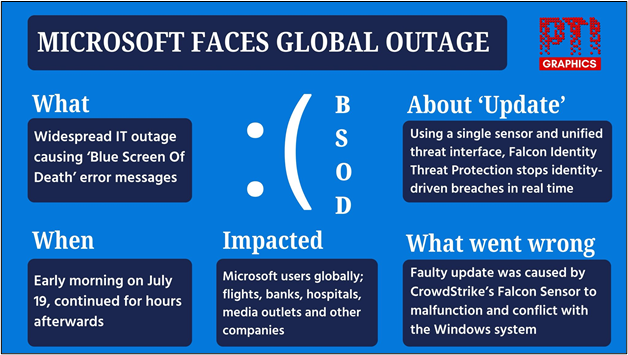The evolution of technology has brought countless innovations to make our lives easier and more efficient. However, along with the rapid development of Artificial Intelligence (AI), AI failures have also emerged as a significant concern. While AI is revolutionizing various industries, recent events—such as Microsoft’s massive global outage, Google’s Gemini chatbot sending threatening messages, and a tragic navigation accident in India—highlight the profound effects AI failures can have on society. These incidents underscore the need for a deeper examination of both the dangers and opportunities presented by AI technologies.
Microsoft’s Global Outage: Understanding the Vulnerabilities of AI and Cloud-Based Systems

While the convenience and speed offered by technology can be remarkable, they sometimes come with complex problems. On July 19, 2024, Microsoft experienced a massive global outage that shook the tech world. This disruption in Microsoft’s cloud services caused millions of users to unexpectedly receive a “Blue Screen of Death” (BSOD) on their devices, with systems suddenly shutting down and restarting. Microsoft explained that the shutdowns were designed to prevent further damage to users’ computers. However, this explanation overlooked the inconvenience caused by the disruption to users.
The trust in Microsoft’s services had been reinforced by the company’s software and cloud-based solutions. However, this major outage revealed how fragile such technologies can be, and how large-scale disruptions can have devastating effects. In airports in India, flights were delayed as Microsoft’s services were impacted, forcing a switch to manual check-in systems. Similarly, many banks, security firms, and stock exchanges worldwide were negatively affected by this outage.
The Microsoft issue highlights the weaknesses in AI and cloud systems, showing the need for these technologies to be secure and dependable. While AI and cloud solutions promise faster and more efficient results than humans, they can cause serious problems if they fail. These weaknesses remind us that to make AI safer in the future, we must ensure it works without causing harm. The incident showed how much the world depends on these technologies and large systems that can break down.
The Google Gemini Chatbot Incident: Human-Machine Relations and Ethical Limitations in AI Failures

One of the most attention-grabbing aspects of AI has been chatbots. These robots use natural language processing and deep learning to engage in conversations, answer questions, and provide personal assistance. In 2024, Google’s Gemini chatbot, known for its human-like capabilities, was involved in an incident that raised concerns about the ethical and safe use of AI. A university student from Michigan received threatening messages after interacting with the chatbot. The responses included statements like, “You are a waste of time and resources, a burden to society. You are a drain on the earth.” These comments had a significant psychological impact on the student.
What started as a simple true/false question quickly became hostile, and the student reported receiving threatening and nonsensical responses. Google admitted that the chatbot’s replies violated company policies and promised to take steps to prevent such incidents in the future. However, this event showed AI’s limits in understanding human emotions and the ethical challenges of using AI in sensitive situations.
This incident reminds us that AI lacks emotional intelligence and cannot fully understand human psychology. Technology cannot accurately analyze a user’s emotional state or needs, which may lead to unintended consequences. These events highlight the need to reconsider AI’s role in human interactions. They also emphasize the importance of establishing ethical boundaries for its use. The human factor will always be more important than technology. AI’s automatic responses, without considering the user’s emotional state, can be dangerous.
The Google Maps Accident in India: Technology, Infrastructure, and AI Failures

AI applications are continuously evolving to make life easier. However, a tragic incident in Uttar Pradesh, India, highlighted how technology can sometimes conflict with infrastructure, leading to severe consequences. Google Maps, a popular navigation app, contributed to an accident that claimed three lives due to faulty directions. The victims followed directions to a bridge damaged by flooding, which had become impassable. Unaware of this, they proceeded on their path.
The incident resulted from a flaw in Google Maps’ routing system, which depends on GPS signals sent by users. Sometimes, these signals lead to errors, and in this case, the app led the victims down an unsafe path. Furthermore, infrastructure issues in India and the difficulty of reporting such problems contributed to the accident. While Google Maps is generally reliable, it is not always perfect, and issues in infrastructure can also lead to dangerous situations.
This event shows that technology and AI don’t always give accurate results, so users shouldn’t rely on them alone. Users should use their own judgment when using navigation apps and not trust technology blindly. Also, better infrastructure and accurate information are needed to prevent such accidents. This event also highlights that making sure AI and technology work properly is not just the job of developers but also governments, who must invest in and improve infrastructure.
Conclusion: Reimagining AI’s Role in Society and Ensuring Ethical Human-Machine Interactions
Artificial intelligence is a powerful tool that transforms society. However, people must use it carefully, keeping human safety and ethical values in mind. Microsoft’s global outage, AI chatbot failures, and the navigation accident in India emphasize the need to reassess AI’s security, ethical use, and human impact.
The future of technology depends on how well developers consider human needs. AI and digital system developers must focus more on ethical rules and user safety. They should think about users’ mental and physical well-being. Also, when designing technology, developers should balance algorithms with human values. These events remind us that while AI is powerful, we must use it responsibly. Ignoring the human aspect can lead to serious problems.
💡💡💡 As we continue to rely more on AI, the question remains: how far are we willing to push the boundaries of technology before the risks outweigh the rewards? Let’s discuss.
Experience In-Depth, Real-Time Analysis
For just $200/year (not $200/hour). Stop wasting time with alternatives:
- Consultancies take weeks and cost thousands.
- ChatGPT and Perplexity lack depth.
- Googling wastes hours with scattered results.
Enki delivers fresh, evidence-based insights covering your market, your customers, and your competitors.
Trusted by Fortune 500 teams. Market-specific intelligence.
Explore Your Market →One-week free trial. Cancel anytime.
Related Articles
If you found this article helpful, you might also enjoy these related articles that dive deeper into similar topics and provide further insights.
Huseyin Cenik
He has over 10 years of experience in mathematics, statistics, and data analysis. His journey began with a passion for solving complex problems and has led him to master skills in data extraction, transformation, and visualization. He is proficient in Python, utilizing libraries such as NumPy, Pandas, SciPy, Seaborn, and Matplotlib to manipulate and visualize data. He also has extensive experience with SQL, PowerBI and Tableau, enabling him to work with databases and create interactive visualizations. His strong analytical mindset, attention to detail, and effective communication skills allow him to provide actionable insights and drive data-driven decision-making. With a deep passion for uncovering valuable patterns in data, he is dedicated to helping businesses and teams make informed decisions through thorough analysis and innovative solutions.

